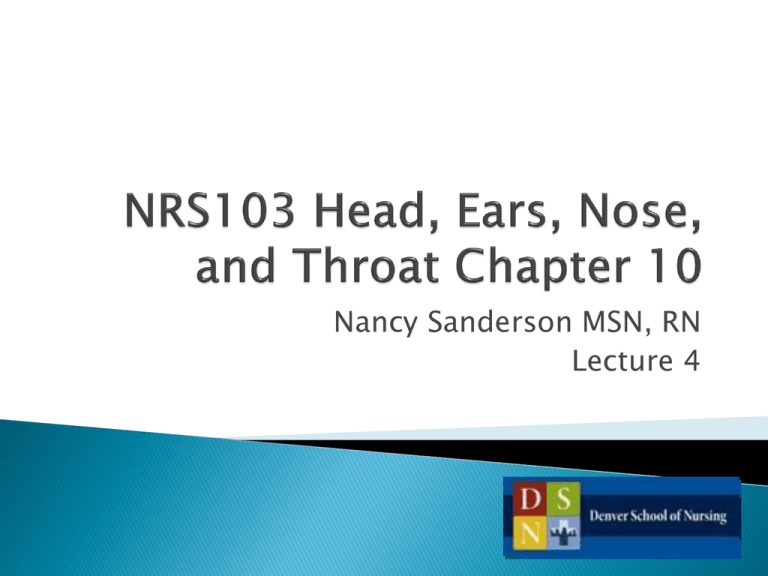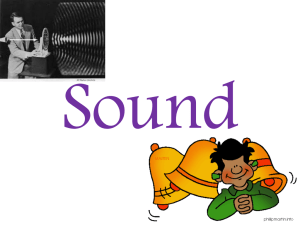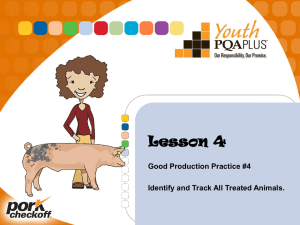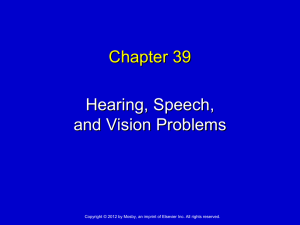External Ear
advertisement

Nancy Sanderson MSN, RN Lecture 4 Feature concept: Sensory perception ◦ Ability to understand and interact through senses: Sight Hearing Smell Taste Touch Copyright © 2013 by Mosby, an imprint of Elsevier Inc. 2 Recent head trauma? Loss of consciousness? Headaches? I.e.: Sinus, migraines, neurological Use of a helmet when appropriate? I.e.: occupation, contact sports, cycling, and skateboarding. Head and neck contain multiple structures: ◦ Skull encloses brain. ◦ Facial structures include eyes, ears, nose, and mouth. ◦ Neck structures include: Upper portion of spine Esophagus Trachea Thyroid gland Arteries Veins Lymph nodes 4 Copyright © 2013 by Mosby, an imprint of Elsevier Inc. Skull is a bony structure that protects brain and upper spinal cord: ◦ Contains special senses of vision, hearing, smell, taste. ◦ Comprises six bones fused at sutures. ◦ Covered by scalp tissue typically covered with hair. Face comprises 14 bones: ◦ Mandible articulates with temporal bone to form temporomandibular joint. ◦ Facial muscles innervated by cranial nerves V (trigeminal) and VII (facial). 5 Copyright © 2013 by Mosby, an imprint of Elsevier Inc. 6 Copyright © 2013 by Mosby, an imprint of Elsevier Inc. • • • Inspect and palpate: Inspect the head for size shape and skin characteristics. I.e.: Head in relation to neck and shoulders for size and shape. Normocephalic term designating that the skull is symmetric and appropriately proportioned for the size of the body. Versus microcephaly and macrocephaly. Inspect facial features for size, symmetry, movement, skin characteristics, and facial features. • • All facial features should appear symmetric with a calm facial expression. Facial bones should be symmetric and proportional to the size of the head. Palpate the structures of the skull for contour and, tenderness and intactness. Palpation takes place when there is suspected injury, observed irregularity or abnormality or reported pain. The skull should be symmetric, and feel firm without tenderness. Palpate the bony structures of the face, jaw, and movement of the jaw, temporal arteries for: tenderness, jaw pain, clicking, pulsation of artery. External ocular structures: ◦ External eye is composed of eyebrows, upper and lower eyelids, eyelashes, conjunctivae, and lacrimal glands. ◦ Palpebral fissure is opening between eyelids. ◦ Conjunctivae are two thin, transparent mucous membranes, between eyelids and eyeball. Bulbar conjunctiva covers scleral surface of eyeball. Palpebral conjunctiva lines eyelids and contains blood vessels, nerves, hair follicles, and sebaceous glands. 11 Copyright © 2013 by Mosby, an imprint of Elsevier Inc. Inspect the conjunctiva of the eye for color, drainage and lesions. This is done by gently pulling done the lower eye lid. No drainage, redness or swelling should be noted. Inspecting the sclera of the eye commonly referred to as the whites of the eye for erythema, jaundice, or lesions. Sclera should be white and clear although in darker pigmented individuals the sclera may have a slight yellowing to the sclera. • Snellen Chart distance vision cranial nerve II Patient sits or stands twenty feet from the chart. Patient reads the line of the smallest letters that are possible for them to read. Test the other eye in the same manner then both eyes. Document findings according to the fraction printed on the Snellen chart. You must also document if the patient is wearing corrective lenses or contacts at the time. Pupils for size, shape, reaction to light, accommodation and consensual reaction. Determine the pupil size with a pupil gauge Using a pen light approaching from the side and shining the light directly into the pupil observing for a reaction of the pupil to the light. Consensual reaction the constriction of the iris and the pupil of one eye when a light is shown in the opposite eye. Accommodation ask the patient to fix her gaze on an pen light or finger, observe the eyes as you move the object in and away from the face. The pupils will dilate and constrict when focusing on objects near and far as a simultaneous response, consensual response. PERRLA- pupils equal round reacts to light and accommodating. • • • Six muscles attaching the eyeball to the orbit of the eye. These muscles are stimulated by three cranial nerves. CNVI-abducens- innervates the lateral rectus muscle for lateral movement. Abducts the eye. CNVI-trochlear- innervates the superior oblique muscles moving the eye down and in. CNIII- ocular motor- innervates all the rest of the eye moving superior, inferior, medial, rectus and the inferior oblique muscles. Extra ocular muscles function test: EOMhence extraocular movement. The patient to move or follow the eyes keeping head still through the six cardinal positions of gaze. Stand 15 inches away from the patient and off to the side of the patient, shine the light beam on the pupil and look for the orange glow in the pupil. Normally: light reflex. Abnormal: absent light reflex (may be due to opacity of the lens, i.e. cataract) Red reflex present bilaterally. Ear is a sensory organ for hearing and maintaining equilibrium Divided into three sections: ◦ External ear ◦ Middle ear ◦ Inner ear 24 Copyright © 2013 by Mosby, an imprint of Elsevier Inc. External ear ◦ Auricle or pinna and external auditory ear canal composed of cartilage and skin. Helix is prominent outer rim. Concha is deep cavity in front of external auditory meatus. Lobule is bottom portion of ear. ◦ Auricle serves three main functions: Collection and focus of sound waves. Location and direction of sound. Protection of external ear from water and dirt. 25 Copyright © 2013 by Mosby, an imprint of Elsevier Inc. 26 Copyright © 2013 by Mosby, an imprint of Elsevier Inc. 27 Copyright © 2013 by Mosby, an imprint of Elsevier Inc. Sound waves strike the tympanic membrane Vibrations transmit through the auditory ossicles (malleus, incus, stapes) to oval window (Conductive hearing loss to this point) Vibrations travel to cochlea and then to the round window (Sensory hearing loss at this point) CN VIII (acoustic) Nerve sends message to brain How is your hearing? ◦ Use of hearing aid? ◦ Taking ototoxic drugs? Have you had any trouble with your ears or balance? ◦ Are you having any vertigo? (feeling as if the room is spinning, different from dizzy) ◦ Are you having any tinnitus? (musical ringing in the ear) Does anyone smoke in your household? ◦ Increased risk of otitis media in children Use an otoscope with the largest ear speculum that the canal will accommodate Position the patient’s head so that you can see through the scope Straighten the ear canal be grasping the auricle firmly and pull it upward, backward and slightly away from the head Brace your hand against the patient’s face Insert the speculum gently into the ear canal, directing it somewhat down and forward Use an otoscope with the largest ear speculum that the canal will accommodate Position the patient’s head so that you can see through the scope Straighten the ear canal be grasping the auricle firmly and pull it upward, backward and slightly away from the head Brace your hand against the patient’s face Insert the speculum gently into the ear canal, directing it somewhat down and forward Identify the handle of the malleus Identify the short process of the malleus Inspect the pars flaccida and Pars tensa Normal ◦ Shiny, transparent, pearly gray, slight concave, non-bulging, no perforation TM gray and intact bilaterally without erythema, bulging, or retraction. Estimating Hearing ◦ ◦ ◦ ◦ Occlude one ear of your patient Stand 1-2 feet behind patient Whisper a word (i.e. 88) Repeat with other ear Gross hearing intact by whisper test. Weber Test ◦ Tap against palm and place midline vertex of head ◦ Normal: Hears equally in both ears ◦ Conductive hearing lossbest in impaired ear ◦ Sensorineural hearing loss- only in normal ear Rinne Test ◦ Tap against palm and place on mastoid process. When no longer hears place 1-2 cm from ear until no longer hears ◦ Sensorineural hearing loss- heard longer thru air, but less than 2:1 ratio ◦ Normal air conduction (ac) is 2 times longer than bone conduction (bc) Allergic Rhinitis ◦ ◦ ◦ ◦ ◦ Itching Swelling Rhinorrhea Sneezing Tearing eyes ◦ Later- stuffy nose, coughing, decreased smell, sore throat, dark circles under eyes Inspect the anterior and inferior surfaces of the nose ◦ Note any asymmetry or deformity ◦ Inspect for discharge ◦ Test patency Press on each nostril one at a time and have the patient breath in Palpate for any masses, lesions or tenderness Nose symmetrical midline. No deformities or skin lesions. Nares patent bilaterally. Inspect the inside of the nose ◦ Inspect vestibule, septum and turbinates Color of nasal mucosa Foreign body Discharge (note color: clear, yellow, green, bloody) Masses, lesions, polyps Septum: deviation, perforation, bleeding Turbinates: color, swelling, exudate, polyps Normally no swelling, mucoid drainage; redder than oral mucosa Septum without deviation, perforation, or bleeding. Turbinates pink, without dc, edema, exudate, or polyp. Palpate for sinus tenderness ◦ Press up on the frontal sinuses from under the bony brows (avoid pressure on the eyes) ◦ Press up on the maxillary sinuses ◦ Normal: pt will feel pressure but no pain with palpation Frontal and maxillary sinuses nontender to palpation ROS: ◦ ◦ ◦ ◦ ◦ Sore throat Sore tongue Bleeding from the gums Tooth pain Hoarseness Inspect lips ◦ ◦ ◦ ◦ ◦ ◦ ◦ Color Moisture Lumps Ulcers Cracking Symmetry Swelling (edema) Inspect oral mucosa (inside of mouth) ◦ With good light and a tongue blade, inspect for color, ulcers, white patches, and nodules. Lips pink and moist without cracking or lesions. Buccal mucosa pink without nodules or lesions. Teeth/Gums ◦ Inspect for missing teeth, caries, conditions, discoloration ◦ Note the color of the gums ◦ Normal Pink Margins without swelling No bleeding Teeth white, straight, evenly spaced, clean and free of decay. Gums pink without swelling or bleeding. Pharynx ◦ With the patient’s mouth open, have the patient say “ah” As the patient says “ah” check the rise of the soft palate (CN X) ◦ Gag reflex (CN IX , X) ◦ If needed press a tongue blade firmly down upon the midpoint of the arched tongue ◦ Inspect the soft palate, anterior and posterior pillars, uvula, tonsils and pharynx ◦ Note color, swelling, ulceration ◦ Tonsillar enlargement ◦ Exudate ◦ Breath odor (halitosis) Soft palpate pink, rises midline. Tonsils pink without enlargement or exudate. Pharyngeal wall pink without exudate or lesions. No halitosis noted. ROS ◦ ◦ ◦ ◦ Neck pain? Lumps or swelling? History of neck surgery? History of neck trauma? Inspect for: Head position Neck muscle symmetry Masses or scars Abnormal pulsations Neck supple & symmetrical Without masses, scars, or abnormal pulsations Inspect Should be midline Palpate For tracheal shift Place finger in sternal notch and slip to each side. Trachea midline. Palpate the lymph nodes 1. 2. 3. 4. 5. 6. 7. 8. 9. 10. Use the pads of your index and middle fingers with a gentle rotary motion. Preauricular Posterior auricular Occipital Tonsilar Submandibular Submental Superficial cervical Posterior cervical Deep cervical chain supraclavicular Note location, size, shape, delimitation, mobility, consistency and tenderness. Lymph nodes normally nonpalpable in healthy adults Small, soft, mobile, discrete, non-tender nodes (shotty) may be found in normal persons. Enlarged (>1cm) firm, tender, and freely moveable often indicates infection. Hard, non-tender, and fixed often indicates malignancy. Enlarged supraclavicular node, especially on left, suggests possible metastasis from thorax or abdomen No lymphadenopathy noted or lymph nodes nonpalpable. Inspect first then palpate Assess for: Enlargement Goiter Consistency Symmetry Nodules Movement Thyroid nonpalpable Goiter PERRLA Hearing (equal sound –whisper test; finger rubbing; (pupils are equal round and react to light and accommodation) Weber's best) Nose (normal appearance; symmetry; no discolored drainage) Mouth (check for malocclusion; tonsils; dental caries) Throat (Range of motion; palpate [use care] sides & midline all should be midline & nontender)







